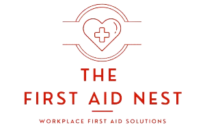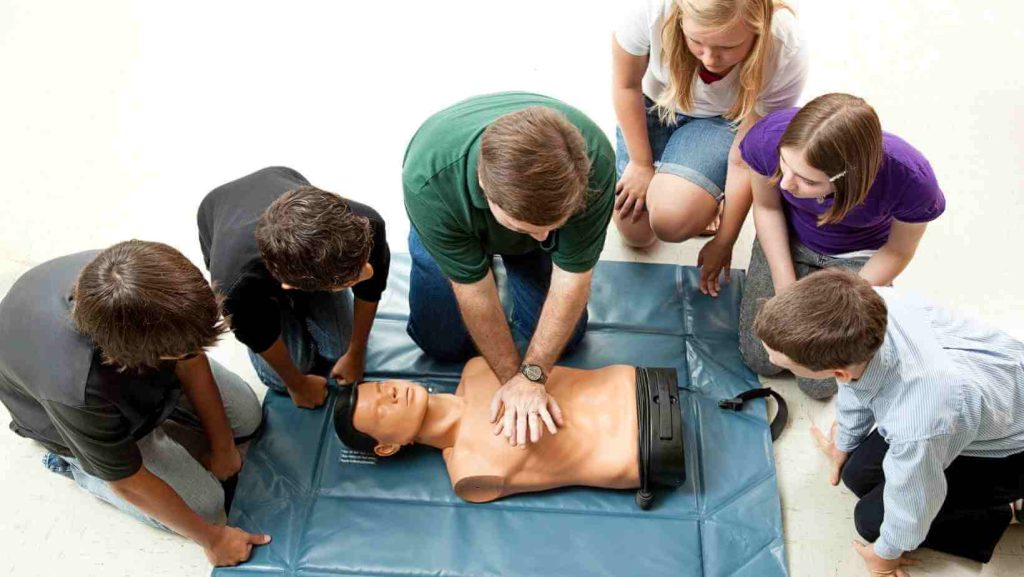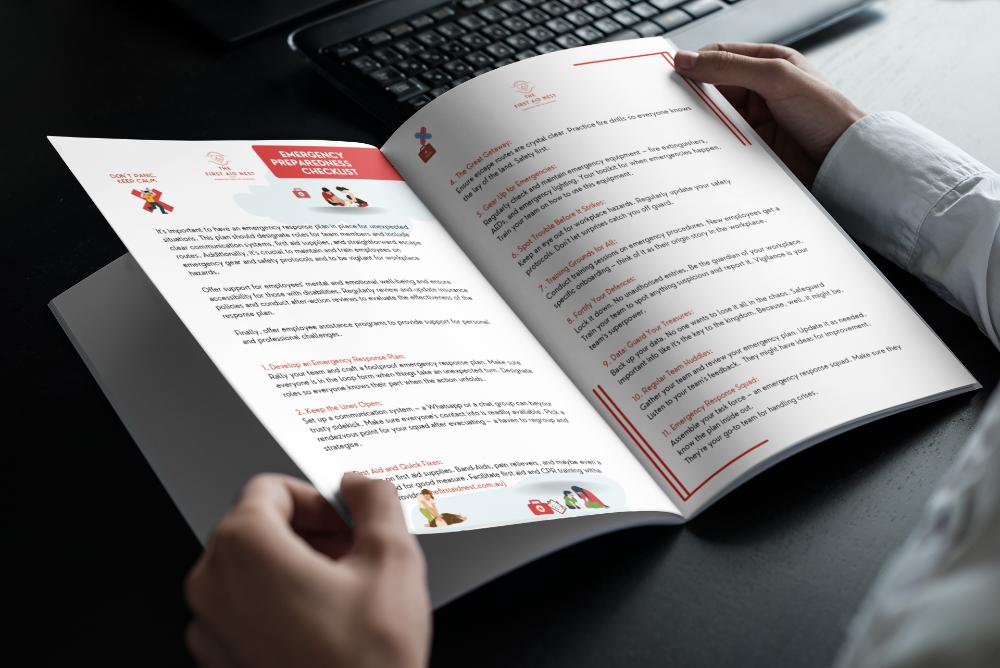Basic First Aid: Teach students to save lives
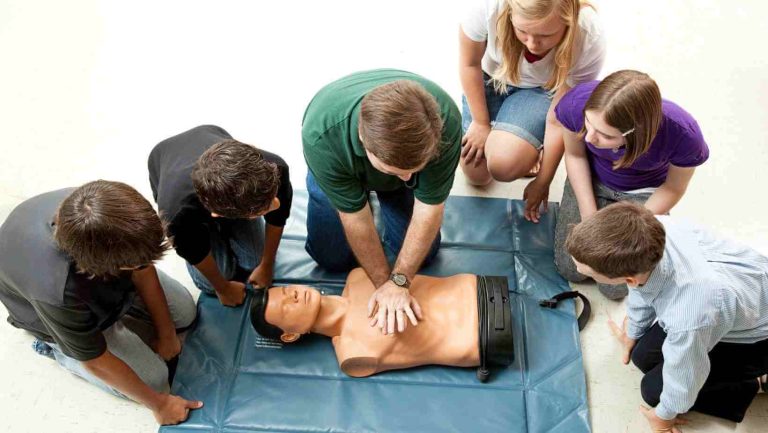
Teaching students how to perform first aid is not just a satisfying job, it is a vocation.
Teaching others lifesaving skills has a massive ripple effect that will, at some point, undoubtedly end up saving a life. And what ripple effect does that life have? Is that person a mother? Father? Son? Daughter? Carer?
Basic First Aid
It starts with the basics. CPR on adults, children and babies.
There are many similarities in performing CPR on adults, children and babies, but there are also very important differences.
CPR is cardiopulmonary resuscitation. It is performed by giving 30 compressions to a person’s chest and 2 rescue breaths (if the rescuer is willing and able)
For an adult, you would use two hands, one on top of the other with fingers interlaced, and push down in a short sharp motion approx ⅓ of the depth of the chest. The breaths should be given with the head slightly tilted back in the ‘sniffing’ position.
With a child (aged 1-8 years) it is recommended that you use one hand to complete the chest compressions and again, the head should be tilted back slightly into the ‘sniffing’ position so that the airway is fully open.
With an infant (0-12 months) 2 fingers should be used to complete the chest compressions and the rescue breaths should be given with the baby’s head in the neutral position (not bent backwards). The infant’s windpipe is like a plastic straw, and if it is bent back, it will kink and could compromise the air supply.
Chest compressions should be performed up on your knees, so that you are not leaning over and straining yourself. In this position, it is easier to use your body strength towards compressions.
The next most important subject to teach is choking. This is one of the most common emergencies. It is also the most common emergency where an ambulance is called and then cancelled. This is likely because the adult or child received effective and appropriate first aid and recovered quickly.
- If a child/adult is choking well – let them cough & keep them calm
- If there is noisy breathing or the cough becomes weaker, call an ambulance and start first aid
- Give 5 back blows between the shoulder blades with the heel of your hand, checking for removal of the blockage between blows.
- If no change, give 5 chest thrusts using 2 fingers for an infant, one hand for a child & adult. Have the casualty up against a chair or wall or laying on the floor. Check between the chest thrusts for the foreign body.
- If the casualty stops breathing at anytime, start CPR
- You can learm more from our free choking chart pdf
First Aid Courses
Some of the skills we learn in first aid courses may seem pretty basic, but actually if we don’t perform these skills correctly, it may make no difference to helping the casualty at all. For instance, during an asthma attack, if an inhaler is not given properly due to the spacer not fitting the face or the puffs of inhaler being given too quickly, or not using a spacer at all, the casualty may not even get the medication and the situation could worsen rapidly.
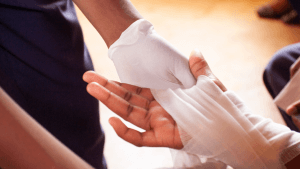
If a casualty has anaphylaxis but the rescuer does not know how or where to give the epipen, this may result in the anaphylaxis taking hold, the person falling unconscious and requiring way more than one dose of adrenaline.
The same goes for a major bleed. A person could bleed to death with a major haemorrhage in 5 minutes, but it is possible to completely stop a major bleed if you use the correct technique.
- A casualty with a life threatening bleed should be laid down and kept warm.
- Pressure should be applied, directly or indirectly (if there is an embeded object, don’t remove, but apply pressure around it)
- Still bleeding? Apply a haemostatic dressing or a tourniquet.
- Call emergency services and monitor the patient’s condition.
- If they stop breathing, commence CPR
Another basic of first aid is knowing how to call for help.
During an emergency, there may be a lot of people gathered around, and everyone thinks that someone else has called an ambulance, when actually no one has called an ambulance.
What we recommend is pointing out someone specifically and giving them the instruction.
Example: “You with the yellow jacket on, please call an ambulance”
Simple and very effective. Now everyone knows help is on its way and the person is left in no doubt that it is their job to do so.
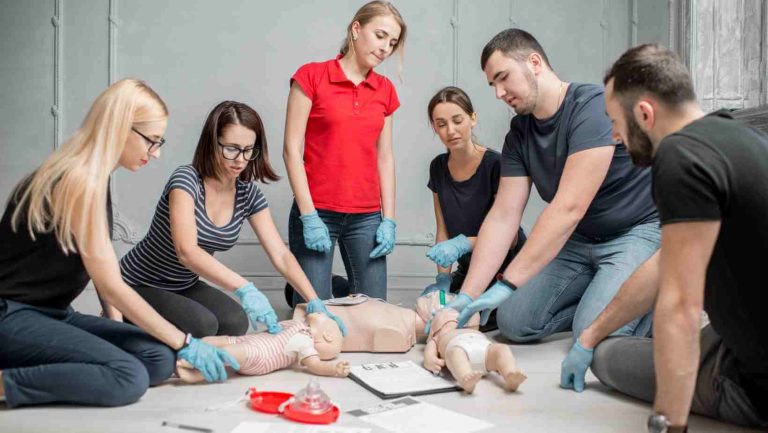
First aid for schools
There are many other ways that education saves lives. According to Global partnership for Education, there are 5 main ways education has a knock on effect to save lives.
- Education reduces child mortality. Educating girls averted more than 30 million deaths of children under 5 years old.
- Education improves nutrition and reduces stunting. If all mothers had a secondary education, 12.2 million children could be saved from stunting (stunted growth)
- Education improves maternal health. If all women had completed primary education by 2010, maternal mortality would have fallen by 66%.
- Education combats life threatening diseases. If all young adults had completed primary education, there would be 700,000 fewer new cases of HIV infections each year or 7 million each decade.
- Education leads to healthy choices. A child whose mother can read is 50% more likely to be immunised, 2 x as likely to attend school and 50% more likely to live past the age of 5 years.
Teaching first aid to high school students
How can we support our young population? By teaching first aid in schools. Not just to the staff but to the young students too. This has a knock on effect of feeling empowered and creating a great team work environment.
Want more? We’ve got you covered…
Our Baby First Aid Courses
Our baby first aid courses are available in person in your home and online. We run classes in your home with groups of 2, 4 or up to 10 in Sydney & Melbourne and you can book in 3 easy steps!
- Pick your class
- Follow the prompts to purchase
- We will contact you within 24 hours to lock in your date of choice
Our First Aid Certificate Courses
We run most of the popular first aid courses Australia wide. HLTAID011 Provide First Aid, HLTAID009 Provide CPR, HLTAID012 Provide First Aid in an Education & Care Setting, RAMOAP (anaphylaxis), Mental Health first aid and CPR/LVR to name a few.
Book your public spot online or contact us if you have a group of 5+ people for onsite training.
Here are some other resources you may enjoy!
FREE GUIDE: Your Virtual Baby First Aid Kit
FREE GUIDE: Introducing Common Allergy Foods & Allergic Reactions
FREE Workplace Emergency Preparedness Plan: Grab this at the bottom of every page!
Follow for baby & child first aid and allergy info and tips on Instagram, TikTok & Facebook all @thenestcpr
